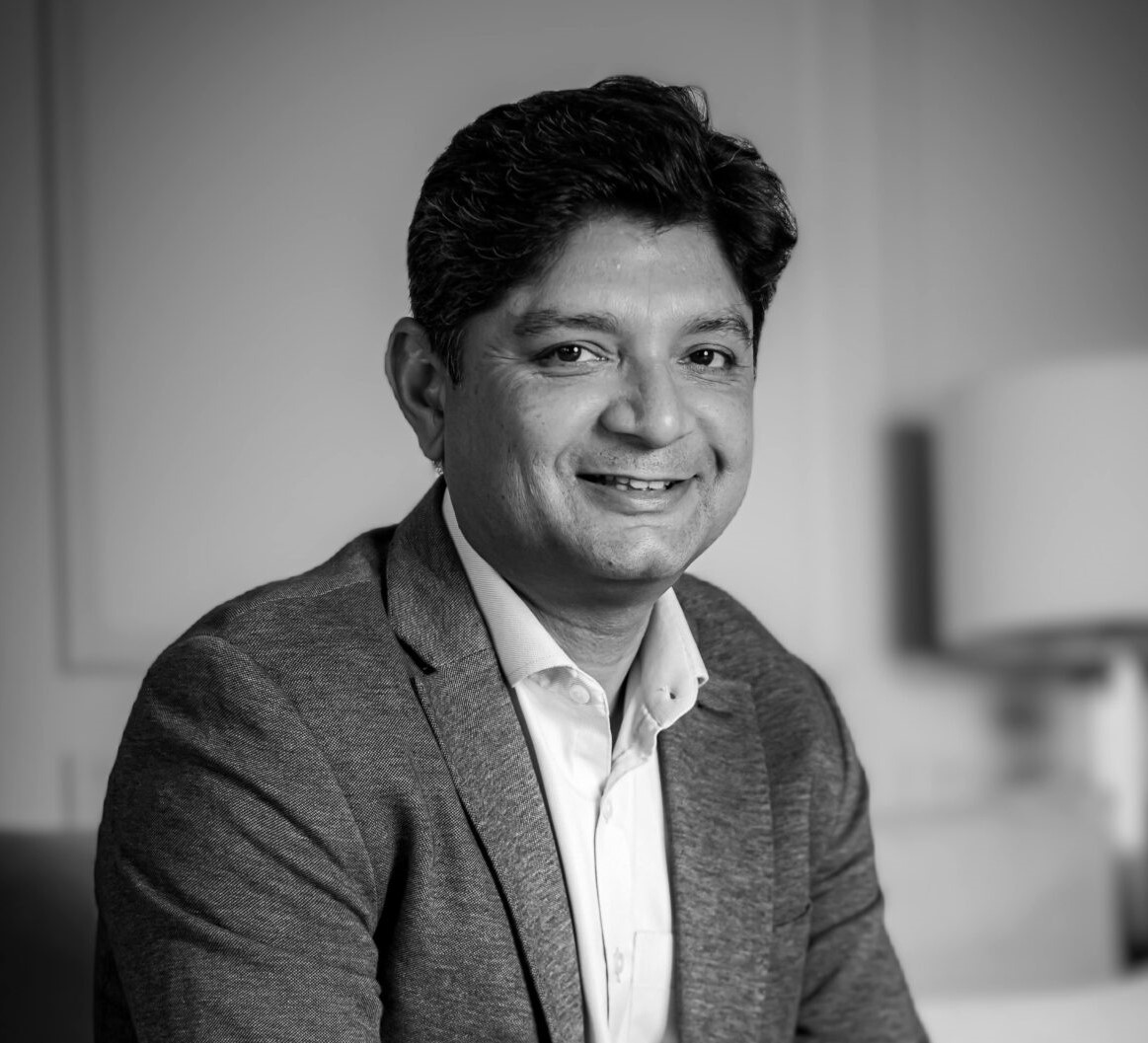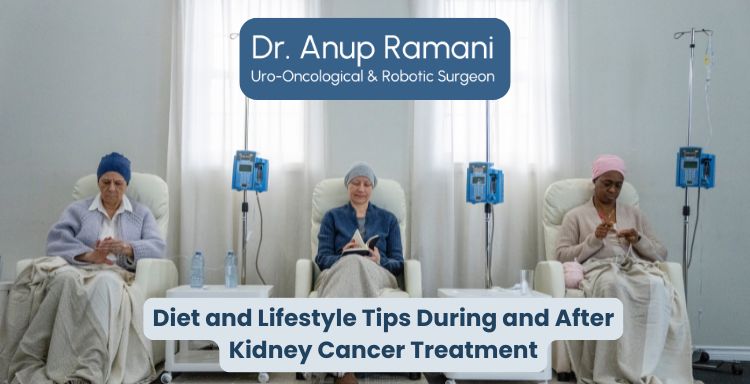Dr Anup Ramani @ Copyright 2024
By Dr. Anup Ramani
Kidney cancer is a significant health concern globally and advancements in medical technology, such as robotic surgery for kidney cancer, are providing patients with effective treatment options. Kidney cancer treatment often requires a combination of surgery, chemotherapy and other interventions to ensure the best possible outcome. However, a key factor that can significantly influence the success of kidney cancer treatment and the recovery process is the patient’s diet and lifestyle. Whether undergoing surgery or managing post-treatment recovery, making appropriate dietary and lifestyle choices can improve a patient’s quality of life, enhance recovery and support the body’s ability to fight the disease. This article delves into essential diet and lifestyle tips that patients can follow during and after kidney cancer treatment.
How Diet Affects Kidney Cancer Treatment and Recovery?
Diet plays a vital role in supporting the body during kidney cancer treatment. A balanced and nutrient-dense diet is necessary to strengthen the immune system, manage side effects and promote tissue repair. Patients undergoing kidney cancer treatment in Mumbai or elsewhere can benefit greatly from dietary recommendations provided by their oncologist or dietitian. These experts may advise adjustments to ensure the body is getting the right balance of nutrients, vitamins and minerals during the recovery process.
Some patients may experience side effects like loss of appetite, nausea or fatigue, which can make it challenging to maintain a healthy diet. Therefore, it is crucial to focus on nutrient-dense, easily digestible foods that provide energy and essential nutrients without overwhelming the digestive system.
Key Dietary Recommendations:
- High Protein Foods: After surgery or treatment, the body needs more protein to heal tissues and maintain muscle mass. Lean meats, eggs, tofu and legumes can provide excellent sources of protein.
- Hydration: Staying well-hydrated is crucial, especially for those who have undergone surgery or radiation therapy. Drinking sufficient water, herbal teas or clear soups can prevent dehydration and help flush toxins from the body.
- Fruits and Vegetables: These provide a rich source of antioxidants, vitamins and minerals, which can support the immune system and reduce inflammation.
- Whole Grains: Foods like brown rice, quinoa and oats offer fiber, which can improve digestion and regulate blood sugar levels, a critical factor in maintaining overall health during treatment.

What Foods to Avoid During Kidney Cancer Treatment
While certain foods are essential during treatment, others can be detrimental to the healing process. Kidney cancer treatments, especially surgeries like robotic surgery for kidney cancer, can place stress on the kidneys and other organs, making it important to limit foods that could interfere with recovery.
Foods to avoid include:
- Excessive Salt: High-sodium foods, such as processed meats and canned goods, should be avoided to prevent fluid retention and strain on the kidneys.
- Sugary Foods and Beverages: Excess sugar can contribute to weight gain and may affect insulin levels, which could complicate recovery. Avoiding sugary sodas, candies and processed snacks can help keep blood sugar levels stable.
- Alcohol: Alcohol consumption should be minimized or avoided altogether, as it can impair liver function and affect the body’s ability to heal.
- Red and Processed Meats: These types of meats contain compounds that may increase inflammation and are harder to digest, putting extra stress on the body during recovery.
What Our Patients Are Saying
When to Begin Adjusting Your Diet During Kidney Cancer Treatment
Dietary adjustments should ideally begin as soon as a kidney cancer diagnosis is made. Early dietary intervention can help the body build strength before undergoing treatments like robotic surgery for kidney cancer. Post-surgery, diet modifications should continue to support recovery, healing and minimize complications like infection or organ strain.
During surgery recovery, patients may be encouraged to eat soft, easy-to-digest foods initially and gradually transition to a balanced, solid diet as the body heals. The oncologist or kidney cancer surgeon in India can guide the patient on when and how to resume a regular diet.
Where Lifestyle Changes Can Make a Difference in Kidney Cancer Recovery
A holistic approach to recovery, involving not just diet but also lifestyle changes, can be highly beneficial in supporting the body’s healing process. Simple lifestyle modifications can go a long way in aiding recovery, improving overall health and minimizing the risk of recurrence.
Key lifestyle tips include:
- Regular Physical Activity: Once cleared by the medical team, moderate exercise like walking or yoga can improve circulation, strengthen muscles and boost energy levels.
- Stress Management: Managing stress through techniques like meditation, deep breathing or mindfulness can help improve mental clarity and overall well-being during recovery.
- Adequate Sleep: Restful sleep is crucial for healing and immune system function. Creating a sleep-friendly environment and establishing a regular sleep routine can help support recovery.
- Quit Smoking: Smoking can interfere with healing and may reduce the effectiveness of certain treatments. It’s crucial for patients to quit smoking to support their kidney health and overall recovery.
How to Monitor Your Progress and Seek Help When Needed
During kidney cancer treatment and recovery, it is essential to monitor changes in your body and lifestyle to ensure that the adjustments you are making are working effectively. Regular consultations with your healthcare team, also include consulting Dr. Anup Ramani, as a specialized kidney cancer surgeon in India, can help identify any issues early on and make necessary adjustments to your diet or lifestyle.
Patients should keep track of its dietary intake, any side effects, energy levels and changes in weight. If any concerns arise, such as sudden weight loss, dehydration or difficulty eating, it is important to seek advice from a healthcare professional immediately.
Conclusion
Diet and lifestyle play an integral role in supporting patients during and after kidney cancer treatment. By making informed decisions about their nutrition, hydration, physical activity and mental well-being, patients can enhance their recovery, improve their quality of life and reduce the risk of complications. The advice of a qualified kidney cancer surgeon and other medical professionals, along with personalized dietary recommendations, can ensure that patients are on the right track toward healing and long-term health.
For patients undergoing kidney cancer treatment in Mumbai, following these diet and lifestyle tips can significantly improve recovery outcomes and overall well-being. Always consult with healthcare providers before making significant changes to diet or lifestyle to ensure the best care during this critical time.
FAQs About Kidney Cancer Treatment
Can a patient undergo robotic surgery for kidney cancer and still maintain a healthy diet during recovery?
Yes, patients can maintain a healthy diet during recovery from robotic surgery for kidney cancer. It is essential to follow dietary recommendations provided by healthcare professionals, focusing on protein, hydration and nutrient-dense foods to support healing.
What foods are recommended to support kidney cancer recovery after surgery?
Foods rich in protein, antioxidants and vitamins are recommended, such as lean meats, fish, fruits, vegetables, whole grains and hydrating fluids like water and herbal teas.
How soon can I start making lifestyle changes after kidney cancer treatment?
Lifestyle changes can begin shortly after treatment, with approval from your healthcare team. Physical activity, stress management and adequate sleep can significantly improve your recovery process.
Is it necessary to avoid all processed foods after kidney cancer surgery?
While it’s best to limit processed foods, particularly those high in salt, sugar and preservatives, it may not be necessary to completely eliminate them. Focus on a balanced diet rich in whole foods and limit processed food intake.
About Author

Uro-Oncological & Robotic Surgeon
Dr. Anup Ramani is a robotic uro-oncological surgeon and an internationally recognized expert in robotic surgery for prostate, kidney and urinary bladder cancers. With more than two decades of robotic experience and 2,000+ robotic procedures, he brings unmatched precision and outcomes to complex uro-oncology cases. He is widely published in his field and is known for a personal, transparent approach-often spending over an hour in initial consultations to educate patients on its disease, surgery and recovery. His expertise spans prostate cancer treatment, kidney and bladder cancer surgery, adrenal gland surgery, kidney stone treatment, penile cancer surgery and enlarged prostate management. Dr. Ramani advocates the advantages of robotic surgery-magnified 3D vision, tremor-filtered precision, minimal scarring, lower blood loss and faster recovery-helping patients return to life sooner.
Table of Contents
Recent Blogs
Best Uro-Oncological surgeon
Specialist in India for Robotic Surgery
MCh, DNB, MS, DNB
Dr. Anup Ramani
CONTACT
Uro-Oncologist in India,
Best Robotic Surgeon for Uro Oncology Surgery
1407, One Lodha Place Next to World Towers Senapati Bapat Marg, Worli, Mumbai. 400013.
Dr Anup Ramani @ Copyright 2024 – Website Maintenance, SEO & GEO by Opal Infotech
- Partial penectomy is done in cases where glans and distal penis is involved with carcinoma.
- Partial penectomy is a type of organ-preserving surgery. Preservation of sexual and micturational function depends on the surgical dissection and reconstruction of residual urethra.
- Patients who develop stones in the kidney or ureter, often experience severe pain.
- This condition usually needs a procedure to remove the kidney stones.
- This procedure is called ureteroscopy and is performed very commonly.
- It does not require any cuts and hence it is painless.
- The procedure is performed with an endoscope inserted through the penis under spinal anesthesia.
- The scope is inserted through the penis into the kidney and stones are dissolved with a laser.
- The procedure takes about 40-50 minutes.
- A catheter (urine pipe) is kept after the procedure to drain the bladder. A stent is kept in the kidney at the same time.
- Patient is mobile and walking in the room the same evening.
- Hospital stay is one night and patient is discharged the next day after removal of the catheter.
- Patient has to come back after six weeks to remove the stent in the kidney.
- Patients can resume office a week after surgery and heavy activities like running, weight lifting, a month after the procedure.
- We offer fixed packages for this procedure which can be obtained by calling our helpline +91 9967666060.
- Men with an enlarged prostate, which is a normal ageing changes, often experiencing difficulty passing urine. This condition usually needs a procedure to trim the prostate and relieve the blockage.
- This procedure is called TURP and is performed very commonly.
- It does not require any cuts and hence it is painless.
- The procedure is performed with an endoscope inserted through the penis under spinal anaesthesia.
- The overgrown prostate is dissolved with a laser bloodlessly.
- The procedure takes about 40 minutes.
- A catheter (urine pipe) is kept after the procedure to drain the bladder.
- Patient is mobile and walking in the room the same evening.
- Hospital stay is two nights and patient is discharged with the catheter, which is removed after 4 days.
- Patients can resume office a week after surgery and heavy activities like running, weight lifting, a month after the procedure.
- We offer fixed packages for this procedure which can be obtained by calling our helpline +91 9967666060.
-
Robotic adrenalectomy is a sophisticated, complex surgery and it is very important that an experienced surgeon performs this surgery to avoid major complications.
-
Once the anesthesia is done, and patient positioned, three micro cuts (3mm each) are made in the patient’s abdomen.
-
The arms of the Da Vinci robot are connected to the cuts via ports (tubes).
-
Dr. Ramani then sits in the controlling console to perform the surgery.
-
On an average, a robotic adrenalectomy takes one hour.
-
The surgery is almost completely bloodless and there has never been any need to transfuse blood after surgery.
-
A urine catheter and bag to drain the bladder is inserted during surgery.
-
A tiny drain pipe may be inserted in the surgical side of the abdomen, connected to a bag.
-
Patient is kept nil-by-mouth the day of the surgery, with IV fluids. Sips of water are started the next day and solid food by day three.
-
The drain pipe, if kept, is removed in the room on day 2 after surgery.
-
The catheter is removed on day two after surgery.
-
Total hospital stay for robotic adrenalectomy is 4 nights (including night before surgery).
-
Post discharge, a doctor from the surgical team visits the patient at home/ hotel room once every day.
On the day of discharge, patient is totally self-sufficient. They are able to walk freely without any pain, dress themselves, shower, toilet and they do not need to hire any nurse or help at home. Almost all patients are back to work within 2 weeks of surgery.
Heavy activities like running, weight lifting can be resumed after a month
Follow up after an adrenalectomy is in the form of CT scans, once a year for 5 years.
Local patients usually meet Dr. Ramani after two weeks to discuss report.Outstation patients are counselled on a phone consultation.
- Dr. Ramani is one of the very few surgeons in India who has the expertise to perform a robotic surgery for bladder cancer, which includes removing the urinary bladder and reconstructing a new bladder robotically.
- Robotic radical cystectomy is an extremely sophisticated, complex surgery and it is very important that an experienced surgeon performs this surgery to avoid major complications.
- Once the anaesthesia is done, and patient positioned, six micro cuts (3mm each) are made in the patient’s abdomen.
- The arms of the Da Vinci robot are connected to the cuts via ports (tubes).
- Dr. Ramani then sits in the controlling console to perform the surgery.
- On an average, a robotic radical cystectomy with an ileal conduit takes 3-4 hours.
- The surgery is almost completely bloodless and there has never been any need to transfuse blood after surgery.
- A urine catheter and bag to drain the new bladder is inserted during surgery.
- Two tiny drain pipe in inserted in the surgical side of the abdomen, connected to a bag.
- Patient is kept nil-by-mouth for 4 days after surgery with IV supplementation of patient’s daily requirements of calories, fats, carbohydrates, proteins and electrolytes.
- The drain pipes are removed in the room on day 3-5 after surgery.
- Total hospital stay for radical cystectomy is 8 nights (including night before surgery).
- Post discharge, a doctor from the surgical team visits the patient at home/ hotel room once every day.
- On the day of discharge, patient is totally self-sufficient. They are able to walk freely without any pain, dress themselves, shower, toilet and they do not need to hire any nurse or help at home.
- Almost all patients are back to work within 6 weeks of surgery. Heavy activities like running, weight lifting can be resumed after two months.
Follow up after a radical a cystectomy is in the form of CT scans, once a year for 5 years.
Histopathology report: Local patients usually meet Dr. Ramani after two weeks to discuss report.
Outstation patients are counselled on a phone consult. Depending on the report, patient may or may not need chemotherapy after surgery.
If chemo is needed, patients may choose to get it done with a medical oncologist of their choice or avail the services of one of the four medical oncologists on our team.
- Robotic partial nephrectomy is a sophisticated, complex surgery and it is very important that an experienced surgeon performs this surgery to avoid major complications. Robotic radical (total) nephrectomy is
- relatively easier but still requires significant experience to consistently deliver results.
- Once the anaesthesia is done, and patient positioned, five micro cuts (3mm each) are made in the patient’s abdomen.
- The arms of the Da Vinci robot are connected to the cuts via ports (tubes).
- Dr. Ramani then sits in the controlling console to perform the surgery.
- On an average, a robotic radical nephrectomy takes one hour and a robotic partial nephrectomy takes about an hour and half.
- The surgery is almost completely bloodless and there has never been any need to transfuse blood after surgery.
- A urine catheter and bag to drain the bladder is inserted during surgery.
- A tiny drain pipe in inserted in the surgical side of the abdomen, connected to a bag.
- Patient is kept nil-by-mouth the day of the surgery, with IV fluids. Sips of water are started the next day and solid food by day three.
- The drain pipe is removed in the room on day 3 after surgery. The catheter is removed on day two after surgery.
- Total hospital stay for radical/partial nephrectomy is 4 nights (including night before surgery).
- Post discharge, a doctor from the surgical team visits the patient at home/ hotel room once every day.
- On the day of discharge, patient is totally self- sufficient.
- They are able to walk freely without any pain, dress themselves, shower, toilet and they do not need to hire any nurse or help at home.
- Almost all patients are back to work within 2-3 weeks of surgery.
- Heavy activities like running, weight lifting can be resumed after a month.
- Follow up after a radical/partial Nephrectomy is in the form of CT scans, once a year for 5 years.
- Local patients usually meet Dr. Ramani after two weeks to discuss report.
- Outstation patients are counselled on a phone consultation.





